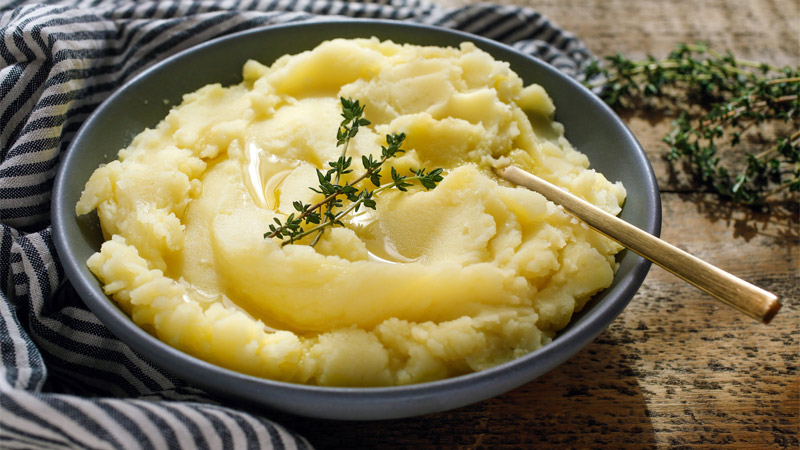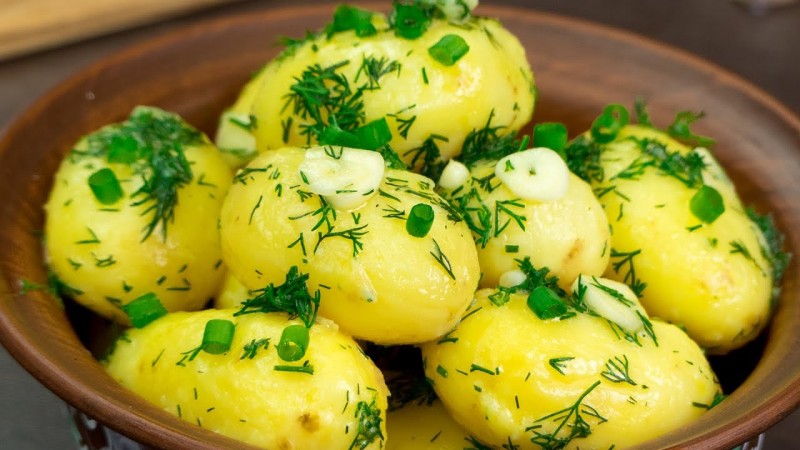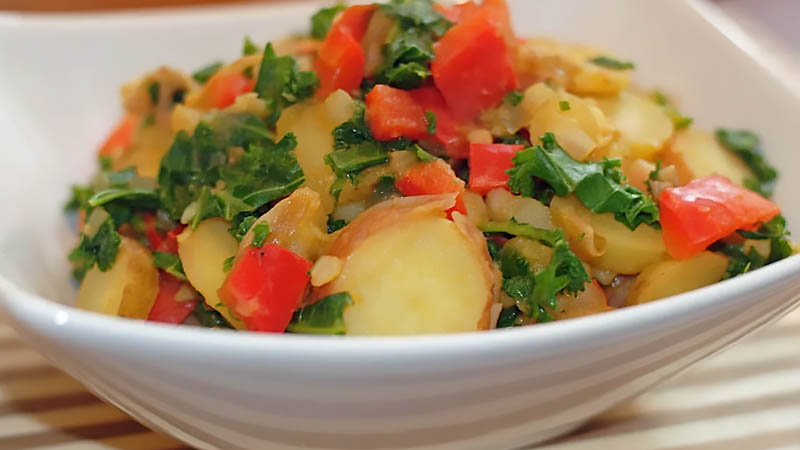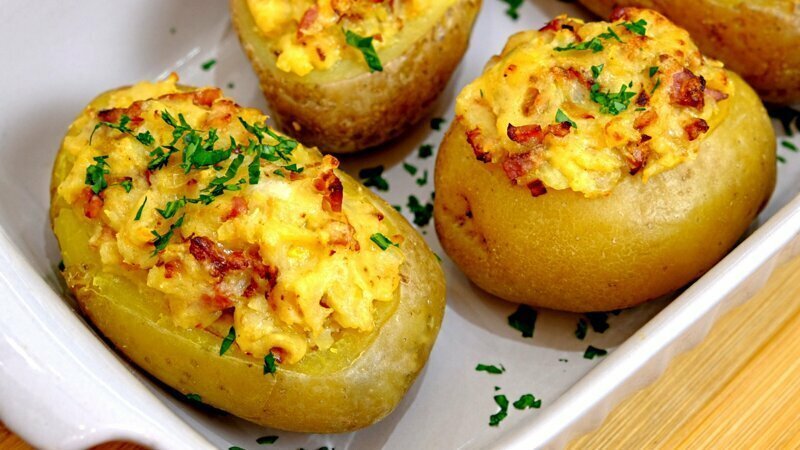Choosing crumbly and tasty potatoes: which variety is right
The variety of potato dishes is very large, but not every variety is suitable for use in a particular recipe. Along with taste preferences, there are objective indicators: starchiness of tubers, friability and wateriness. The fried potatoes will not burn, and the mashed potatoes will be tender and uniform if you use the varieties of potatoes strictly for their intended purpose.
Read below which varieties of potatoes are the most crumbly and delicious and which ones are prepared.
The content of the article
What are crumbly potatoes for?
In Russia, Ukraine and Belarus, they love starchy, crumbly potatoes. It is used for making mashed potatoes, casseroles, pie fillings, zraz and pancakes.
The granular structure of friable potatoes well absorbs various liquids - butter, milk, sour cream - which makes the dish especially tasty.
 Abroad, more waxy potatoes are preferred, as they are ideal for salads, and semi-starchy varieties used to make French fries.
Abroad, more waxy potatoes are preferred, as they are ideal for salads, and semi-starchy varieties used to make French fries.
There is a special marking on the packaging of imported products:
- A - salad-type potatoes;
- B - a slightly boiled variety for chips;
- C - medium-rich potatoes for deep-frying;
- D - very easy to boil, for puree.
Due to which friability is achieved
What kind of potatoes are crumbly? The one with a high starch content. Its percentage of proteins is especially important. Even very mealy potatoes keep their shape well if they contain 6-8 times more starch than protein. If the proportion is 1:16, the potatoes will boil and crumble.
The main reason is the strength of molecular compounds. In wax varieties, the cleavage reaction occurs at a temperature of 12 ° C higher than in starchy ones. That is, the intercellular connections in crumbly potatoes are destroyed even with a slight heat treatment, due to which granularity is achieved.

Many factors affect the chemical composition and physical properties of a vegetable:
- Features of the vegetative cycle. Super-early and early varieties do not have time to accumulate a large amount of dry matter, including starch.
- Agrotechnics. An excess of nitrogenous fertilizer makes the potatoes more watery.
- Collection time. Young (slightly unripe) potatoes are always less starchy.
- Terms and conditions storage... Lowering the temperature to 0 ... + 1 ° C leads to the decomposition of starch to sugars, which gives the potato a characteristic sweet taste. Sprouted tubers lose nutrients as they are spent on sprouting.
- Cooking technique. Presoaking and boiling in cold water removes starch, making the potatoes less crumbly.
Which potatoes are more crumbly - red or white
There is no clear distinction in the technological properties of red and white potatoes. In the minds of many buyers, red and pink tubers are less crumbly, because the first imports of potatoes with such a peel were categories A and B. In current realities, this border has been erased and depends on the specific variety.
White potatoes are perceived to be more starchy. For varieties bred in Russia and the countries of the former CIS, this judgment is often correct, but there are exceptions.
Reference. If you buy only tubers with pink or red peel for preparing a salad, in 7 out of 10 cases this choice will be correct.
With yellow flesh
For a long time, yellow potatoes were considered fodder. Later it turned out that the rich color of the pulp indicates the presence of carotene (vitamin A). They are especially rich in the Peruvian varieties Papa Amarilla, which on the cut look like fatty butter.
Yellow potatoes are not very crumbly, they keep their shape well, therefore they are ideal for frying... Most often it is low in calories, therefore it is suitable for children and dietary food.
Reference. Yellow flesh occurs in "white-skinned" varieties (Adretta, Anosta, Veneta, Zekura) and red-skinned potatoes (Bellarosa, Red Scarlett, Rosara, Symphony).
Description and photos of boiled potatoes
In order not to be disappointed in the texture and taste of the dish, choose the right potatoes.
Mashed potatoes

Highly starchy, highly digestible tubers are ideal for mashed potatoes. They are easiest to knead and the texture of the dish will be even and silky. If for these purposes you take more waxy and watery varieties, there is a high probability of getting a lumpy puree or a slurry resembling a paste.
Reference. It is better to lay the tubers in boiling water in order to preserve the maximum of nutrients. Water is immediately drained from the finished potato so that the pulp does not absorb excess moisture. Knead the potatoes while they are warm.
Suitable varieties for mashed potatoes:
- Aurora, or Little Red Eye... Mid-season variety of Russian selection with pink tubers. It grows well on sandy soils, therefore it contains little moisture and a sufficient amount of starch - 13.5-17.3%.
- Sineglazka. Mid-season amateur variety. Not included in the State Register. The skin has a gray-pink tint, the eyes are blue-violet, the flesh is white. Easy to boil, starch content - 15%. The main drawback is poor keeping quality, therefore, it is rare in the markets in the winter-spring period.
- Lorkh. Medium late potatoes, bred back in 1922. Large tubers of light beige color, the peel is slightly flaky. The pulp is white. Contains 23% dry matter, including 15-20% starch. Crumbles during cooking.
For cooking

Which potatoes to choose for cooking - a matter of taste. It depends on individual preferences and the particular dish. Some people like boiled potatoes with sauce, others prefer neat slices. In thick soups (for example, borscht), the tubers are often boiled whole and then kneaded. Starchy potatoes are acceptable for this, but it will make laconic chicken broth cloudy and unappetizing.
Nevertheless, most culinary experts agree that potatoes with a starch content of less than 15% are preferable in soups and boiled form:
- Meteor. Super early grade. The rind and cut are light yellow. The pulp is moderately boiled, does not lose its shape during heat treatment, becomes soft and slightly watery. Starch content - 12-14.9%.
- Gala. Medium early grade. The skin is yellowish, the flesh has a shade from pale to rich yellow. During cooking, it does not change the structure, the starch content is 11-13%
- Zhukovsky early. Available in mid-August. Tubers are pink, medium and large. The pulp is white, firm, slightly watery. Starch - 10-12%.
For frying
For frying, choose potatoes that are not too crumbly so that they retain their shape when stirring. Watery varieties are not suitable - a fried crust on slices will not work. A high sugar content (above 0.5%) will cause the potatoes to burn in the pan.

A few examples of moderately crumbly yellow potatoes:
- Red Scarlett. Dutch early ripening variety with red-purple tubers. The pulp is yellowish, contains 18.6% dry matter, starch - 11-15%.
- Ryabinushka. Medium early potatoes. It is cultivated in the northern regions and central Russia. The peel is light pink, thin. The pulp is creamy, darkens on air or during heat treatment.Starch - 11.9-15%.
- Hope. Mid-season variety. Tubers are elongated-oval, light beige. High starch content - 18-20%. The flesh is creamy, easy to boil, not watery, which makes it ideal for making French fries.
For salads
For salads, crumbly potatoes are unsuitable, since the slices do not hold their shape well, and the hostess risks getting mashed potatoes. Wax grades of category A with the lowest starch content are most suitable for this dish.

Reference. To make the vegetables denser, they are boiled in their uniforms for salad, and the water is salted at the very end of cooking.
Good in salads:
- Romano. Medium early Dutch variety. The tubers are round with a very strong pink skin. The pulp is light creamy, firm. The starch content is 10-13%.
- Nevsky. Medium early potatoes are oblong-rounded, light yellow peel, pale white flesh. Starch - from 10.4 to 14.8%.
- Picasso. A late-ripening variety of Dutch selection. The peel is yellow with reddish eyes. The pulp is creamy. The starch content is only 10-12%.
Culinary reviews

When choosing potatoes for puree, frying and soups, rely on the opinion of the chefs, who have empirically determined the most delicious varieties for themselves.
Alexandra: “I remembered two suitable varieties for frying: Leader and Kolobok. They do not stick together, they have a crispy crust and are crumbly inside. I use Romano for salads. It does not boil, it is kept in separate pieces. Delicate lump-free puree is obtained from Sineglazka. "
Alexei: “I advise you to fry potatoes with red or yellow skin. Tubers of white varieties quickly darken on cut or acquire a bluish tint. Last year's shriveled potatoes are also of little use for frying. "
Oksana: “You cannot get delicious mashed potatoes from the varieties Tsyganka, Kubanka, Nevskaya even after long beating. It is better to take friable potatoes: Chernigov, Bogatyrka, White Dew, Impala. It boils for 7-10 minutes, crumbles by itself, you don't even need to press.
Conclusion
It is impossible and unnecessary to know all the varieties of potatoes by mouth. Often in the store, at best, only the country of origin is indicated, so the buyer has to choose blindly.
Experienced chefs try to remember the varieties they like by their external characteristics: the color of the peel and pulp, the shape of the tubers. Yellow potatoes with red skin are considered the least starchy and crumbly, and domestic and Belarusian varieties with white pulp are best boiled.